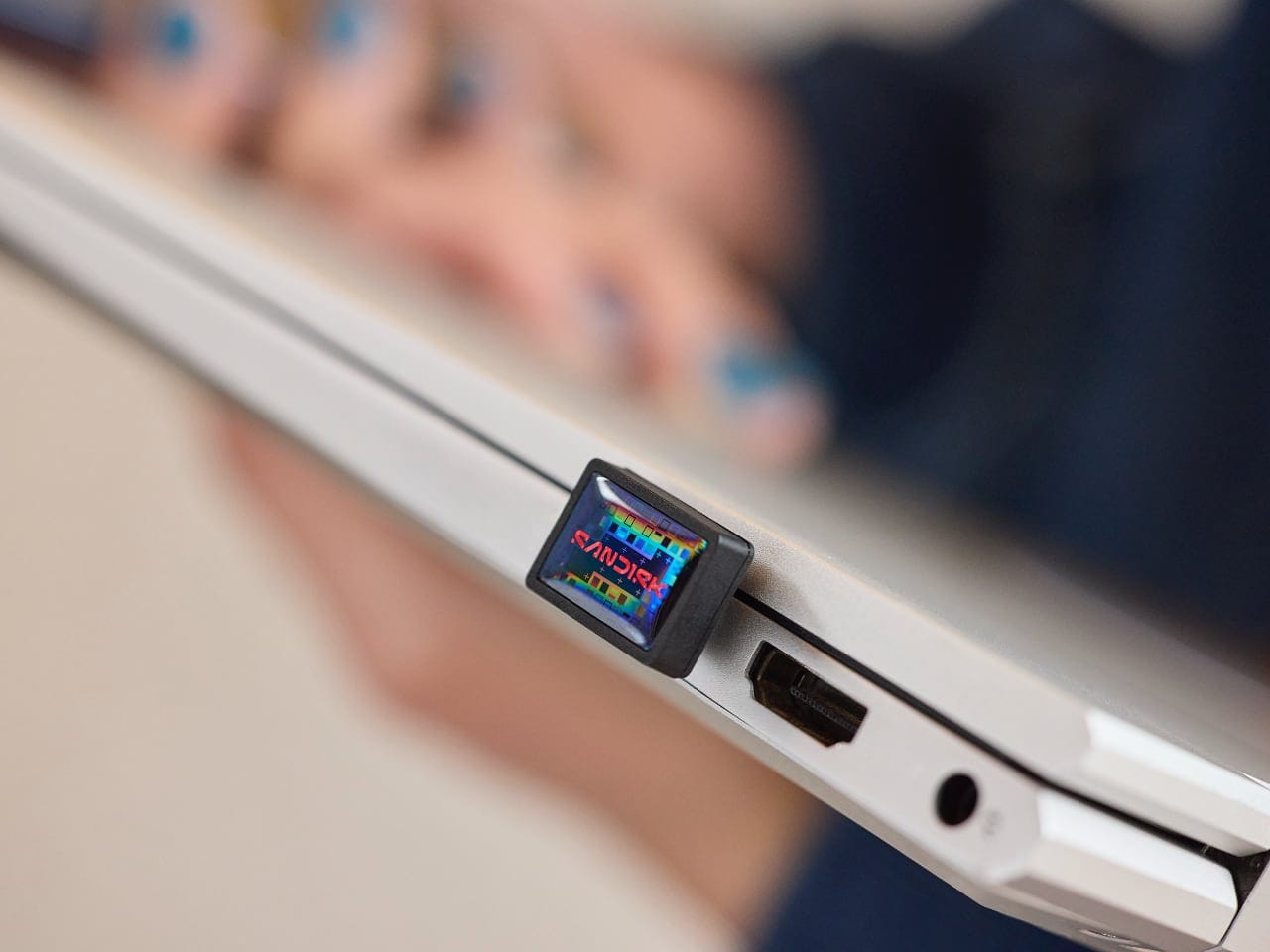Sandisk is going after people who have run out of laptop storage but don’t want to lug around a big external SSD. The new Sandisk Extreme Fit USB-C flash drive is a tiny, leave-in stick that goes up to 1TB and is built to stay plugged into your USB-C laptop or tablet.
- Sandisk has announced the Extreme Fit USB-C flash drive, claimed as the world’s smallest 1TB USB-C flash drive (as of June 2025).
- It’s designed as a “leave-in” drive that sits almost flush with your laptop or tablet.
- Read speeds go up to 400MB/s on 128GB–1TB models, or up to 300MB/s on 64GB.
- The Sandisk Memory Zone app helps with backup and file management on Windows and macOS.
- Aimed at professionals, students, and everyday users who need more storage without carrying a bulky SSD.
Meet the Sandisk Extreme Fit USB-C flash drive
- Claimed as the world’s smallest 1TB USB-C flash drive (based on dimensions as of 24 June 2025).
- USB-C connector for modern laptops, tablets, and other devices.
- Designed to be left plugged in most of the time.
- Targeted at professionals, students, and general everyday use.
In simple terms, this is the “just leave it there and forget it” kind of drive. If you’ve used low-profile USB-A nano drives before, this is the same idea but updated for USB-C and with far more capacity. You get a big bump in storage without changing the way you carry your laptop bag.
We’ve already seen Sandisk play with compact storage on the fun side with the Sandisk x Crayola USB-C flash drives. The Extreme Fit keeps things serious and minimalist instead: small, fast, and meant to disappear into your device.
Ultra-compact “leave-in” design and capacity
The big story is not just the 1TB capacity, but how little space the drive takes around your USB-C port.
- Ultra-compact body designed to sit snugly against laptops and tablets.
- “Leave-in” concept: you plug it in once and mostly forget about it.
- Up to 1TB of storage (1TB = 1,000,000,000,000 bytes; usable space is lower).
- Also available in lower capacities such as 64GB and 128GB.
Because the drive barely sticks out, it’s less likely to snag on bags or sleeves. That’s handy in the UAE, where a lot of people are working between coworking spaces, cafés, and offices, often with laptops constantly going in and out of backpacks.
It’s especially useful on slim machines like modern Ultrabooks or the latest MacBooks, where internal storage upgrades are expensive or impossible. Compared to upgrading an SSD in a desktop (think of something like the WD Blue SN5100 NVMe SSD for creators), this is the low-effort way to add capacity: open the box, plug it in, and you’re done.
Speeds: how fast is “fast enough”?
Sandisk quotes solid read speeds for this size of drive, even though it’s not pretending to replace a high-end NVMe SSD.
- Up to 400MB/s read speeds on 128GB–1TB models.
- Up to 300MB/s read speeds on the 64GB model.
- Actual performance depends on the host device and usage.
- USB-C connection means no dongles for modern laptops and tablets.
In real life, those numbers mean:
Transferring a few gigabytes of photos, documents, or lecture recordings should feel quick. It won’t match a top-tier Gen4 or Gen5 SSD inside your PC, but that’s not the point. For everyday workflows—PowerPoints, PDFs, camera transfers from a trip to Ras Al Khaimah, or backing up a video project—it should be more than enough.
Think of it as the middle ground between a cheap, slow USB stick and a full external SSD. You get decent speed and a lot more capacity than old-school thumb drives, in a form factor small enough to live in your laptop 24/7.
Backup made easier with Sandisk Memory Zone
Storage is useless if your files are a mess. Sandisk leans on its Memory Zone software to help with backup and file management.
- Sandisk Memory Zone app is available for Windows and macOS.
- Lets you organise, back up, and restore files more easily.
- Can be set up for automatic backups within the app.
- Requires a separate download and installation.
The idea is simple: instead of dragging and dropping random files to the drive and hoping for the best, you use the app to set rules. For example, you could back up your Documents and Photos folders to the Extreme Fit on a schedule, which is useful on laptops that move between home, office, and campus Wi-Fi.
The app also helps you restore files if something goes wrong—say you delete the wrong folder on your laptop or need an older copy of a project. It’s not as complex as a full-blown enterprise backup suite, but for most users it’s a big upgrade over “copy-paste and hope”.
If you’re deep into storage tinkering, and curious how removable media is evolving in general, the broader ecosystem now includes faster options like microSD Express, which we’ve covered in detail in our microSD Express explainer. The Extreme Fit sits on the practical, everyday side of that world.
Who is the Sandisk Extreme Fit for?
Sandisk is clear about who it’s targeting with this drive: people who are always on the move and can’t babysit external storage.
- Professionals who carry slim laptops between meetings and client visits.
- Students juggling lecture recordings, assignments, and media on thin-and-light machines.
- Everyday users who need more space for photos, videos, and files without dealing with bulky drives.
- Anyone who prefers local storage over relying only on cloud services.
In the UAE, it fits neatly into some very specific habits. If you’re moving between Dubai and Abu Dhabi on a regular basis, working from cafés, or studying on campus with a laptop that’s already nearly full, a leave-in drive like this can be an easy fix.
You don’t have to think about internet connections, sign in to multiple cloud accounts, or worry about tethering your phone to upload big files. Plug it in once, set up your backup routine, and it just quietly does its job in the background.
FAQ
Is the Sandisk Extreme Fit really the world’s smallest 1TB USB-C flash drive?
Sandisk says the Extreme Fit USB-C is the world’s smallest 1TB USB-C flash drive, based on its physical dimensions as of 24 June 2025. As always with these claims, it’s based on available competing products at that time. The key point is that it’s extremely compact and designed to be left in your device without getting in the way.
What capacities and speeds does the Sandisk Extreme Fit offer?
The Extreme Fit line includes multiple capacities up to 1TB. Sandisk quotes:
- Up to 400MB/s read speeds on 128GB–1TB models.
- Up to 300MB/s read speeds on the 64GB model.
Actual speeds will vary depending on your laptop or tablet and what you’re doing—large file copies, lots of small files, or background tasks can all affect the results.
Does the Sandisk Extreme Fit work with Mac and Windows?
Yes. The drive works with USB-C ports on compatible devices, and Sandisk’s Memory Zone app is available for Windows 10/11 and macOS 11+ (Big Sur and later). You may need to reformat the drive depending on how you want to share files between systems, but out of the box it’s designed to plug straight into modern Mac and Windows laptops.
Can I use the Extreme Fit with phones or tablets?
If your phone or tablet has a USB-C port and supports external storage, you should be able to use the Extreme Fit as you would any other USB-C flash drive—for example, to offload photos, videos, or downloads. Support always depends on the specific device and OS version, so it’s worth checking your phone or tablet’s specs, but the drive itself is built for USB-C devices in general.
Isn't Cloud storage better?
Cloud storage is great when you have a stable, fast internet connection. The Extreme Fit is for the times when you don’t—or when you’d rather not upload everything to the cloud.
- Files stay local and can be accessed offline.
- No subscriptions or data caps to worry about.
- Transfers are often faster than uploading/downloading large files, especially on mobile data.
In reality, many users will combine both: keep active projects on the Extreme Fit, then mirror or archive long-term files to the cloud when they’re back on a strong Wi-Fi connection.

That’s the Sandisk Extreme Fit USB-C flash drive in short: a tiny stick with grown-up storage, built for people who don’t want to think about where their files live until they really have to.
Subscribe to our newsletter to get the latest updates and news







